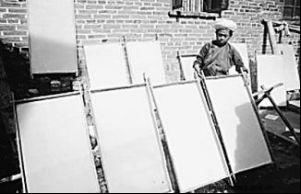精彩推荐
专题推荐
-
没有记录!
热点排行
- 1、新密麻纸手工造纸技艺
- 2、猩猩怪
- 3、祝英台梁山伯传说
- 4、独脚舞
- 5、新郑八千刘家钢勺
- 6、嵩山木版年画
- 7、许由传说
- 8、炭精画艺术——郑州市非物质文化遗产
嵩山木雕
2012/5/17 17:01:18 点击数: 【字体:大 中 小】
嵩山木雕因其浓厚的民族特色和浓郁的嵩山地方特色而名闻遐迩。少林寺、中岳庙历代修缮,都离不开木雕艺人。其梁枋、雀替、藻顶、挂面、格扇门窗、神龛、几案等都需要木雕工艺的装饰。
木雕工艺又称小木作,从技法上讲,有线雕、阴雕、浮雕、圆雕、透雕等,从应用及装饰范围上可分为建筑雕刻、家具雕刻、陈设工艺品雕刻、纪念装饰雕刻等。
嵩山木雕一般采用嵩山本地的大叶杨或椴木等材质,多取材嵩山民间传说、历史典故、宗教故事,以及富有吉祥寓意的福禄寿喜文化。嵩山木雕的风格,不仅有北方木雕的粗犷浑厚,还有南方木雕的精巧秀丽,具有布局均匀、线条流畅、造型洗练和纹样化强的特点,其最明显的特征就是“意匠”,即充分运用我国传统的象征、寓意和祈望手法,结合中华民族的审美意识,从而使嵩山木雕工艺和审美习惯达到和谐统一的境界。
嵩山木雕的代表作是中岳庙大殿的盘龙藻井,群众俗称老龙盘窝。木雕传世作品还有散落于民间的八仙桌、太师椅、匾额、屏风、佛像等。最杰出的嵩山木雕艺术家是芦会,二十世纪在豫西一带享有盛名。
Songshan Wood Carvings
Songshan Wood Carving enjoys a high reputation for its thick national features and local color.
Wood carving is also called little carpentry. In the view of making technology, it can be divided into line carving, embossment, circular engrave, etc; in the view of usage and decoration, they are building carving, furniture carving, crafts carving, memorial decoration carving and so on.
Songshan wood carvings always choose local populus iasiocarpa and basswood as main materials, and folk legends, historical stories and religious tales as major themes, and contains Ferro Shouxi culture as well which has a profound lucky message. They are not only as rough and tense as northern carvings, but also as ingenious and pretty as southern carvings. Songshan Wood Carvings have the characteristics of balanced distribution, fluent linellae, succinct shape as well as various dermatoglyphic patterns. Its biggest feature is Carved with Meaning, that's to say, make full use of Chinese traditional techniques of symbol, implied meaning and wishing, and unit with Chinese aesthetic consciousness so that this wood carving technique and aesthetic habits will fulfill harmony and unity. The most excellent artist is Lu Hui, who earns a good fame in the west region of Henan province in 20th century.
Wood carving is also called little carpentry. In the view of making technology, it can be divided into line carving, embossment, circular engrave, etc; in the view of usage and decoration, they are building carving, furniture carving, crafts carving, memorial decoration carving and so on.
Songshan wood carvings always choose local populus iasiocarpa and basswood as main materials, and folk legends, historical stories and religious tales as major themes, and contains Ferro Shouxi culture as well which has a profound lucky message. They are not only as rough and tense as northern carvings, but also as ingenious and pretty as southern carvings. Songshan Wood Carvings have the characteristics of balanced distribution, fluent linellae, succinct shape as well as various dermatoglyphic patterns. Its biggest feature is Carved with Meaning, that's to say, make full use of Chinese traditional techniques of symbol, implied meaning and wishing, and unit with Chinese aesthetic consciousness so that this wood carving technique and aesthetic habits will fulfill harmony and unity. The most excellent artist is Lu Hui, who earns a good fame in the west region of Henan province in 20th century.
责任编辑:C006文章来源:印象河南网
相关信息
精彩展示
没有记录!
评论区



